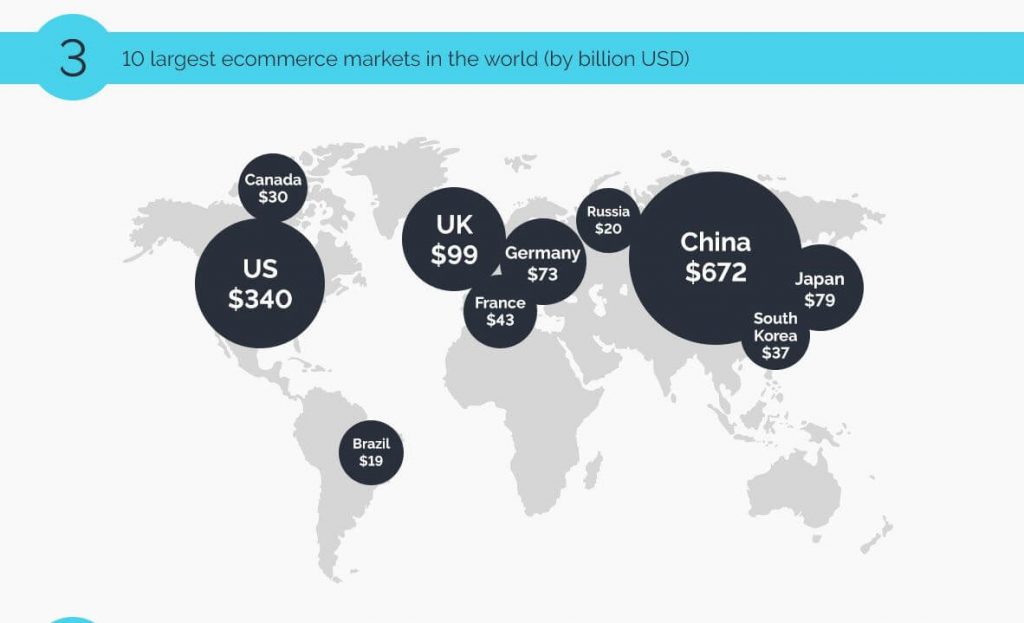B2B ecommerce trends in 2018 are exhibiting future growth of the sector with immense opportunity. The current Infographic reveals several aspects and hints to leverage the most for your B2B ecommerce.
Recently, Forrester in a report has declared that B2B ecommerce growth will remain 12.1% per annum. Thus, it considers a bright future for B2B ecommerce in coming years and optimistic trends in 2018.

B2B eCommerce Market Growth in the US
Besides these predictions, Forrester has cited some acceptable reasons behind the B2B ecommerce growth in 2018 and beyond.
- The changing preferences of the B2B buyers.
- Possibilities to reduce the cost of consumer services using online channels.
- The opening of online shopping channel for B2B customers as a new trend.
Shifting Trends from B2C to B2B Ecommerce
An obvious shift from B2C to B2B ecommerce is becoming apparent in the market. Real credits go to the two factors:
- Rising tendencies toward the self-service. Therefore, 57% B2B ecommerce shoppers run proactive research online.
- Intuitive interface and simplified process on B2B ecommerce sites. It provides the best ordering and buying experiences to the B2B ecommerce shoppers.
10 Large Ecommerce Markets in the World
Recently, ecommerce is trendy and gaining acceptance in several countries of the world. It becomes clear after looking the share of ecommerce in the economy of the respective countries listed here as top ten ecommerce supporters. China resides on the top with $672 billion shares and the USA, and the UK are following it.
B2BEcommerce Growth Rate by Selling Channel
The overall growth of B2B ecommerce is due to growing tendencies in various selling channels such as,
- The growth of distributors was 6.2% from 2016 to 2017
- For manufacturers – 7%
- For retailers – 26.6%
- For wholesalers – 5.8%
Multichannel Integration
Today standalone ecommerce platform is incapable of delivering complex services, features, and functionality. It needs the integration of extensions and extended services through various APIs of third party service providers.
For example,
- On-time delivery and order accuracy like performance metrics improves with shipping service integrations.
- Inventory management enhancement comes with shopping cart integrations.
- Order processing, order accuracy, and on-time order delivery become easy with the integration of different order management systems.
Targeted B2B Ecommerce Customers
The general perception of B2B ecommerce marketers is that only C-suite staff is taking part in buying decision of the B2B businesses. Unfortunately, it is partially true and nearly 81% non-C-suite employees found active influencers and B2B ecommerce marketers have to target them proactively to gain significant leads and conversions.
B2B eCommerce Delivery Options
For B2B ecommerce, local delivery is manageable, but global needs assistance of the third-party logistics and warehouses available in multiple locations. Thus, the B2B ecommerce can enjoy and provide following delivery options to its esteemed customers.
- On-time delivery
- Multiple warehouse facilities
- Automated replenishment
- Partial delivery
- Return management
Effective B2B eCommerce Marketing Channels
To do effective B2B ecommerce marketing, a survey on the contribution of various marketing channels and efforts have been carried out, and it has unveiled following facts.
- The share ofB2B ecommerce websiteis 86%
- Email – 72%
- SEO – 54%
- Social media – 52%
- Blogs – 39%
Thus, we can say that investment in B2B ecommerce website development may prove the worth investment in the long run.
B2B Ecommerce Customers Prefer to Go beyond the Borders
A recent survey on the buying habits of B2B ecommerce shoppers has indicated that 57% B2B ecommerce shoppers prefer to purchase from the overseas storefronts at least once in a year.
Therefore, preparing online B2B stores for a global audience is an essentiality for success.
Conclusion:
B2B is growing tremendously, and the same trends go ahead in 2018 and beyond in the future. Therefore, B2B businesses should be optimistic and prepare for an ecommerce identity to grab the upcoming opportunities.
Author Bio:
Ronak Meghani is a co-founder of Magento IT Solution Pvt Ltd, A Leading B2B eCommerce Development Company in USA and India.


